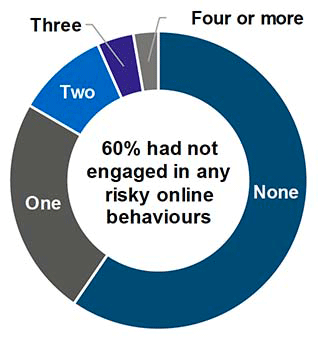Engaging in risky online behaviour - prevalence and associated factors: initial findings
Initial findings on prevalence and associated factors at age 12 from the Growing Up in Scotland Survey on engaging in risky online behaviour.
3. Prevalence of risky online behaviours
Children were asked if they had engaged in each of the six risky online behaviours over the last 12 months. More than half of the children (60%) had not engaged in any of the risky online behaviours. Around a third of children had engaged in one or two of the behaviours, while 7% had participated in three or more, see Figure 3.

Base: 3,419 children from Sweep 9 of GUS study. Variables: CiRir, CilRii, CilRiv, CilRim, CiIRip, CilRil
Of those who had engaged in risky online behaviours, the most commonly engaged in behaviour was adding someone to their friends/contacts list who they had never met face-to-face (33%). Other behaviours were less common, with fewer than 10% of children reporting having participated in each of the other behaviours – see Table A. A small proportion (4%) had sent personal information to someone that they had never met face-to-face.
Engaging in one kind of risky online behaviour increases the likelihood of engaging in another, with statistically significant associations found across all six risky online behaviours. Of these associations, three were found to be moderately associated:
Children who had lied to their parents about what they did online were also likely to have done something online that their parents would disapprove of.
Children who had sent a photo/ video to someone that they had never met face-to-face were more likely to have sent personal information to someone that they had never met face-to-face
Children who had sent a photo/video to someone that they had never met face-to-face were more likely to have added someone to their friends/ contacts they had never met face-to-face.
All other associations were relatively small, see Appendix 10.2 - Table 1. It is important to note that these analysis do not give a measure of the direction of the relationship, and that as mentioned before only a small proportion of children had engaged in more than one of the behaviours.
Table A. Proportion of children engaging in risky online behaviours.
Risky online behaviour : Proportion of children
- Added someone to their friends list/contacts who they had never met face-to-face: 33%
- Done anything online that they know their parents would not want them to do: 9%
- Lied to parents about what they do online: 8%
- Met up with someone face-to-face who you first made contact with online: 7%
- Sent a photo/video of yourself to someone who you have never met face-to-face: 7%
- Sent personal information to someone who you have never met face-to-face: 4%
The majority of children have not engaged in risky online behaviours.
The most common type of behaviour was adding someone to contacts/ friends list.
Base: 3,419 children from Sweep 9 of GUS study. Variables: CiRir, CilRii, CilRiv, CilRim, CiIRip, CilRil
Contact
Email: GUS@gov.scot
There is a problem
Thanks for your feedback